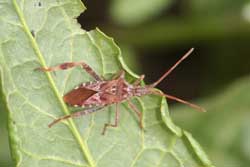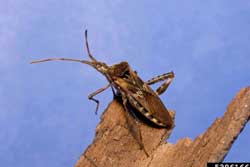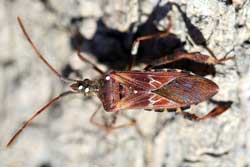Western Conifer Seed Bug—Leptoglossus occidentalis
The western conifer seed bug has become a nuisance pest in many homes. The bugs enter buildings at the onset of cold weather in the late summer or early fall seeking a protected site to spend the winter. These bugs do not bite or sting, and will not damage the structure of your house. One exception is the occasional reported damage to PEX pipes sometimes used in plumbing and radiant heating systems (see Dig Deeper below). They have a pungent odor when handled and make a buzzing sound when they fly.
Click on images to view full-size
Identification
The adult western conifer seed bug is about 3/4 inch in length and is a dull brownish color. There is a faint white zigzag stripe across the midpoint of its upper surface. When the insect takes flight, it lifts the wings to reveal bright yellowish-orange areas on its back. It has long antenna, usually as long as its body. It has thick, flattened tibia on its hind legs. These insects are often mistaken for stink bugs as they produce an unpleasant odor when alarmed.
Control Information
In many instances, organisms that we deem "pests" may not be pests, and other organisms may only be pests in certain instances and control may not always be warranted. Usually, western conifer seed bugs are not considered serious pests and may occasionally be indoors in the winter months. There have been occasional reports of damage to PEX tubing (see Dig Deeper below). Recently, they have been found in Europe and are considered to be serious pests of conifers there.
Factsheets
- Entomological Notes: Western Conifer Seed Bug (PDF)—Penn State College of Agricultural Sciences Cooperative Extension
- Fact Sheet: Western Conifer Seed Bug (PDF)—University of New Hampshire Cooperative Extension
- Tips on Managing Western Conifer Seed Bugs (PDF)—Maine Integrated Pest Management Council
- Insect Series–Trees & Shrubs: Conifer Seed Bugs (PDF)—Colorado State University Extension
- Western Conifer Seed Bug: An Unwanted House Guest (PDF)—Insect Diagnostic Laboratory, Cornell University
Dig Deeper - Scientific Studies
- Damage to common plumbing materials caused by overwintering Leptoglossus occidentalis
Summary: The ability of overwintering L. occidentalis to damage plumbing products represents a significant economic impact for an insect that has been hitherto considered a benign nuisance pest in man-made structures. - Biology, Ecology, and Management of Hemipteran Pests in Almond Orchards in the United States
Summary: Several hemipertan insect pests exist in almond orchards and include lace bugs, plant bugs, stink bugs, and leaffooted bugs. Pests in the hemipteran order use needle-like mouthparts to pierce the surface of plants and fruits, which can cause considerable damage and plant deformities. This paper delves into the biology, ecology, and management practices of these hemipteran pests in almond orchards to summarize the current research available on these pests.
More Information
[Photos, left to right: Whitney Cranshaw, Colorado State University, Bugwood.org; Joseph Berger, Bugwood.org; David Cappaert, Michigan State University, Bugwood.org]


